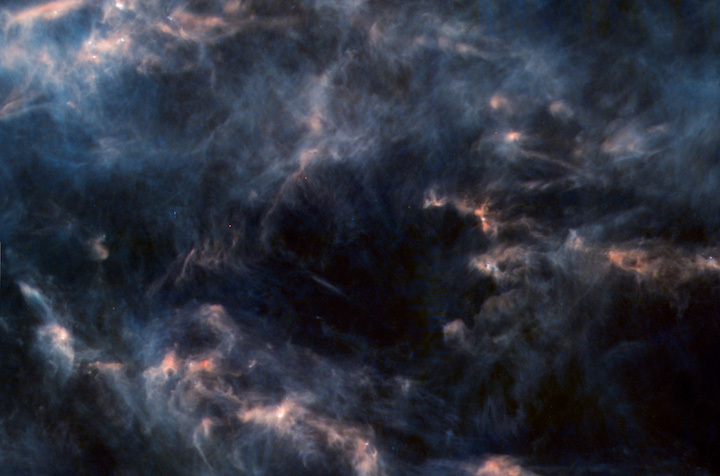7.01.2022
Weak magnetic fields detected by China’s FAST telescope could upend theory of star formation

Dust in the Taurus Molecular Cloud, seen as pink hues in far-infrared light, traces dense regions of gas where stars form. A study of one of the cloud’s stellar embryos suggests the process is fast.ESA/HERSCHEL/NASA/JPL-CALTECH; R. HURT/JPL-CALTECH/CC-BY-SA
Astronomers have long thought it takes millions of years for the seeds of stars like the Sun to come together. Clouds of mostly hydrogen gas coalesce under gravity into prestellar cores dense enough to collapse and spark nuclear fusion, while magnetic forces hold matter in place and slow down the process. But observations using the world’s largest radio telescope are casting doubt on this long gestational period. Researchers have zoomed in on a prestellar core in a giant gas cloud—a nursery for hundreds of baby stars—and found the tiny embryo may be forming 10 times faster than thought, thanks to weak magnetic fields.
“If this is proven to be the case in other gas clouds, it will be revolutionary for the star formation community,” says Paola Caselli from the Max Planck Institute for Extraterrestrial Physics, who was not involved with the research.
Studying star birth and the tug of war between gravity and magnetic forces has been a challenge because the magnetic fields can be 100,000 times weaker than Earth’s. The only direct way to detect them comes from a phenomenon called the Zeeman effect, in which the magnetic fields cause so-called spectral lines to split in a way that depends on the strength of the field. These spectral lines are bright or dark patterns where atoms or molecules emit or absorb specific wavelengths of light. For gas clouds, the Zeeman splitting occurs in radio wavelengths, so radio telescopes are needed. And the dishes must be big in order to zoom in on a small region of space and reveal such a subtle effect.
Previously, researchers had used Puerto Rico’s Arecibo radio telescope—which collapsed in 2020—to study Lynds 1544, a relatively isolated stellar embryo within the Taurus Molecular Cloud, just 450 light-years away from Earth. They measured the magnetic fields in the wispy layers of gas far out from the core, where magnetic forces dominated over gravity. They also analyzed the stronger fields inside the core, where gravity nevertheless dominated because the core is 10,000 times denser than the outer layer, says Richard Crutcher, a radio astronomer at the University of Illinois, Urbana-Champaign.
What was missing was an examination of the intermediate region between the core and the outer layer. That has now come into focus with a new tracer of the Zeeman effect—a particular hydrogen absorption line—detected by the Five-hundred-meter Aperture Spherical radio Telescope (FAST), a giant dish built inside a natural basin in southwestern China.
In a study published today in Nature, researchers report a magnetic field strength of 4 microgauss—no stronger than in the outer layer. “If the standard theory worked, the magnetic field needs to be much stronger to resist a 100-fold increase in cloud density. That didn’t happen,” says Di Li, the chief scientist of FAST who led the study.
“The paper basically says that gravity wins in the cloud: That’s where stars start to form, not in the dense core,” Caselli adds. “That’s a very big statement.”
The finding implies that a gas cloud could evolve into a stellar embryo 10 times quicker than previously thought, says lead author Tao-Chung Ching of the Chinese Academy of Sciences’s National Astronomical Observatories.
Li says he wants to study other molecular clouds to see whether the lessons from Lynds 1544 apply more generally. This could be done with FAST or radio telescope arrays such as the Very Large Array in New Mexico, or the upcoming Square Kilometre Array in South Africa and Australia.
Using the Zeeman effect tracer detected by FAST, astronomers might even be able to measure the magnetic field strength in the accretion disks of gas and dust around newly born stars. That would help scientists better understand the initial conditions of planet formation, says Patrick Hennebelle, a theoretical astrophysicist at the French Alternative Energies and Atomic Energy Commission.
Since it opened in 2016, FAST has been a major force in the search for spinning, collapsed stars known as pulsars. The new result shows how its sharp vision and exquisite sensitivity “should lead to major advances in all areas of radio astronomy, including star formation,” Crutcher says.
In April 2021, FAST was officially opened up to astronomers from outside China. Li says FAST received applications from 16 countries, and that some 10% to15% of the facility’s observing time has now been allocated to users outside China.
Quelle: AAAS

